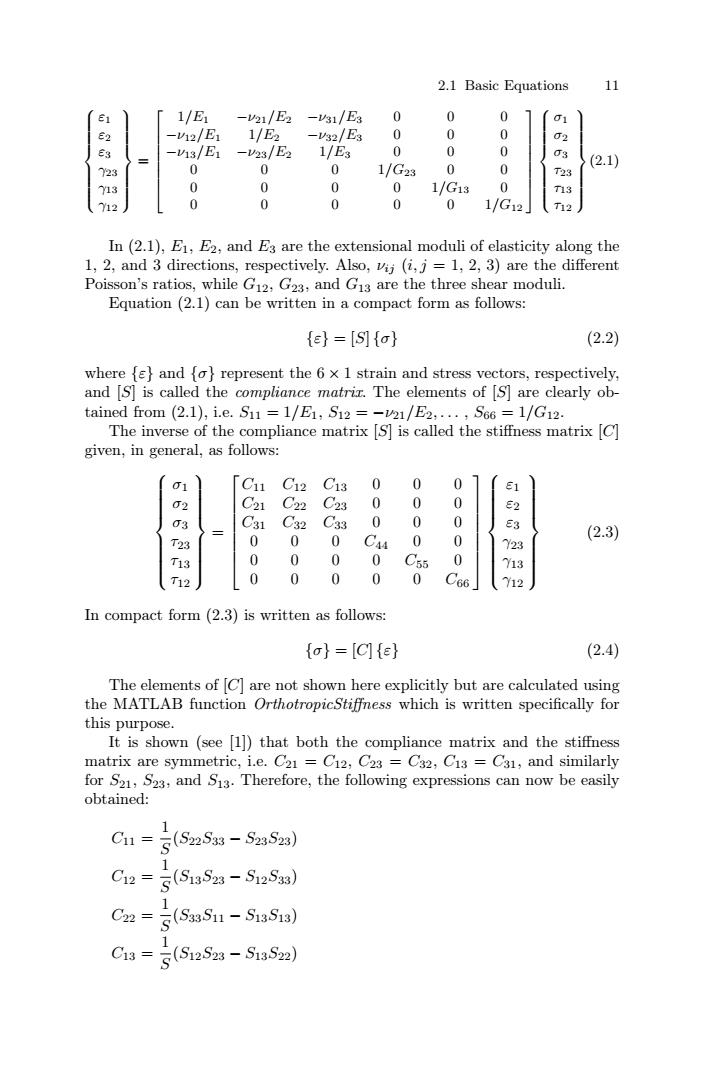正在加载图片...

2.1 Basic Equations 11 E1 1/E1 -21/E2 -31/E3 0 0 01 -M2/E1 1/E2 -32/E3 0 0 0 02 Es -3/E1 -23/E2 1/E3 0 0 0 S 0 0 1/G23 0 (2.1) 23 0 0 1/G13 T13 12 0 0 0 0 1/G12」 T12 In(2.1),E1,E2,and E3 are the extensional moduli of elasticity along the 1,2,and 3 directions,respectively.Also,vij(i,j=1,2,3)are the different Poisson's ratios,while G2,G23,and G3 are the three shear moduli. Equation (2.1)can be written in a compact form as follows: {e}=[S{a} (2.2) where fe}and fo}represent the 6 x 1 strain and stress vectors,respectively, and [S]is called the compliance matrir.The elements of [S]are clearly ob- tained from(2.1),i.e.S11=1/E1,S12=-21/E2,..,S66=1/G12 The inverse of the compliance matrix [S]is called the stiffness matrix [C] given,in general,as follows: C11 C12 C13 0 0 0 E1 6 C21 C22 C23 0 0 0 03 C31 C32 C33 0 0 0 T23 0 0 0 CM 0 0 (2.3) Y23 T13 0 0 0 0 0 Y13 T12 0 0 0 0 0 C66 Y12 In compact form(2.3)is written as follows: {o}=[C{e} (2.4) The elements of [C]are not shown here explicitly but are calculated using the MATLAB function OrthotropicStiffness which is written specifically for this purpose. It is shown(see [1])that both the compliance matrix and the stiffness matrix are symmetric,i.e.C21=C12,C23 C32,C13 =C31,and similarly for S21,S23,and S13.Therefore,the following expressions can now be easily obtained: 1 C1=552s5a8-sa52a C12=5(51523-51253) C2=5(53351-513513) C13=5(512S23-S13.52)2.1 Basic Equations 11 ⎧ ⎪⎪⎪⎪⎪⎪⎨ ⎪⎪⎪⎪⎪⎪⎩ ε1 ε2 ε3 γ23 γ13 γ12 ⎫ ⎪⎪⎪⎪⎪⎪⎬ ⎪⎪⎪⎪⎪⎪⎭ = ⎡ ⎢ ⎢ ⎢ ⎢ ⎢ ⎢ ⎣ 1/E1 −ν21/E2 −ν31/E3 000 −ν12/E1 1/E2 −ν32/E3 000 −ν13/E1 −ν23/E2 1/E3 000 0 0 01/G23 0 0 0 0 0 01/G13 0 0 0 0 0 01/G12 ⎤ ⎥ ⎥ ⎥ ⎥ ⎥ ⎥ ⎦ ⎧ ⎪⎪⎪⎪⎪⎪⎨ ⎪⎪⎪⎪⎪⎪⎩ σ1 σ2 σ3 τ23 τ13 τ12 ⎫ ⎪⎪⎪⎪⎪⎪⎬ ⎪⎪⎪⎪⎪⎪⎭ (2.1) In (2.1), E1, E2, and E3 are the extensional moduli of elasticity along the 1, 2, and 3 directions, respectively. Also, νij (i, j = 1, 2, 3) are the different Poisson’s ratios, while G12, G23, and G13 are the three shear moduli. Equation (2.1) can be written in a compact form as follows: {ε} = [S] {σ} (2.2) where {ε} and {σ} represent the 6 × 1 strain and stress vectors, respectively, and [S] is called the compliance matrix. The elements of [S] are clearly obtained from (2.1), i.e. S11 = 1/E1, S12 = −ν21/E2,... , S66 = 1/G12. The inverse of the compliance matrix [S] is called the stiffness matrix [C] given, in general, as follows: ⎧ ⎪⎪⎪⎪⎪⎪⎨ ⎪⎪⎪⎪⎪⎪⎩ σ1 σ2 σ3 τ23 τ13 τ12 ⎫ ⎪⎪⎪⎪⎪⎪⎬ ⎪⎪⎪⎪⎪⎪⎭ = ⎡ ⎢ ⎢ ⎢ ⎢ ⎢ ⎢ ⎣ C11 C12 C13 000 C21 C22 C23 000 C31 C32 C33 000 000 C44 0 0 0000 C55 0 00000 C66 ⎤ ⎥ ⎥ ⎥ ⎥ ⎥ ⎥ ⎦ ⎧ ⎪⎪⎪⎪⎪⎪⎨ ⎪⎪⎪⎪⎪⎪⎩ ε1 ε2 ε3 γ23 γ13 γ12 ⎫ ⎪⎪⎪⎪⎪⎪⎬ ⎪⎪⎪⎪⎪⎪⎭ (2.3) In compact form (2.3) is written as follows: {σ} = [C] {ε} (2.4) The elements of [C] are not shown here explicitly but are calculated using the MATLAB function OrthotropicStiffness which is written specifically for this purpose. It is shown (see [1]) that both the compliance matrix and the stiffness matrix are symmetric, i.e. C21 = C12, C23 = C32, C13 = C31, and similarly for S21, S23, and S13. Therefore, the following expressions can now be easily obtained: C11 = 1 S (S22S33 − S23S23) C12 = 1 S (S13S23 − S12S33) C22 = 1 S (S33S11 − S13S13) C13 = 1 S (S12S23 − S13S22)